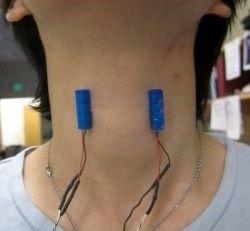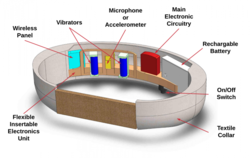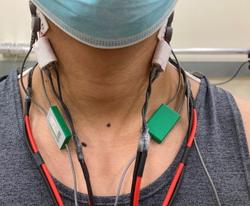Laryngeal Vibration as a Treatment for Spasmodic Dysphonia

Spasmodic dysphonia (SD) is a voice disorder that leads to strained or choked speech. Current therapeutic options for treating SD are very limited. SD does not respond to conventional speech therapy and is treated primarily with Botulinum toxin injections to provide temporary symptom relief. There is no cure for SD.
Vibro-tactile stimulation (VTS) is a non-invasive neuromodulation technique that our laboratory developed for people with SD. Our team documented that a one-time 30-minute application of VTS can result in measurable improvements in the voice quality of people with SD. For the relevant scientific publication, see here.
Wearable Device to Treat Spasmodic Dysphonia

Spasmodic dysphonia (SD) is a voice disorder that leads to strained or choked speech. SD is unresponsive to speech therapy. Currently, the primary treatment is Botulinum toxin injection that provides temporary symptom relief. Our preliminary work showed that voice quality in SD improves when vibro-tactile stimulation (VTS) is applied to the larynx as a form of non-invasive neuromodulation. What is needed is a wearable device that applies VTS during daily life. In this project we designed and build such a device and a sample of people with abductor SD tested its wearability and effectiveness.
Vibro-Tactile Stimulation to Treat Cervical Dystonia

Cervical Dystonia (CD) is a neurological movement disorder that is characterized by abnormal head movements or postures caused by involuntary contractions of neck muscles. The aim of this project is to explore vibro-tactile stimulation of neck muscles as a non-invasive, non-pharmacological treatment method for individuals with CD.
Neural Correlates of Abnormal Proprioception in Cervical Dystonia

Cervical dystonia (CD) is a movement disorder characterized by sustained or intermittent contractions of neck muscles causing abnormal, often repetitive, head movements and postures. This study pursued two major goals. First, using a psychological assessment, investigate for possible signs of proprioceptive dysfunction. Second, using EEG analysis, find underlying neural correlates of such proprioceptive dysfunction in people with CD.
Completed